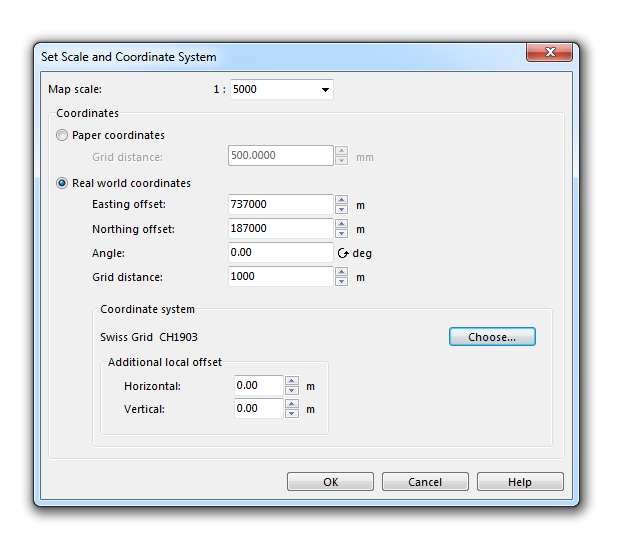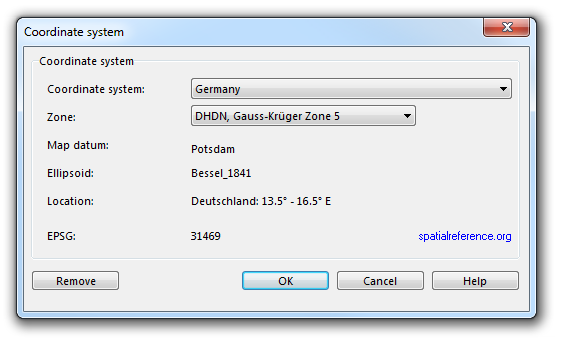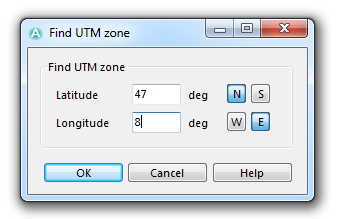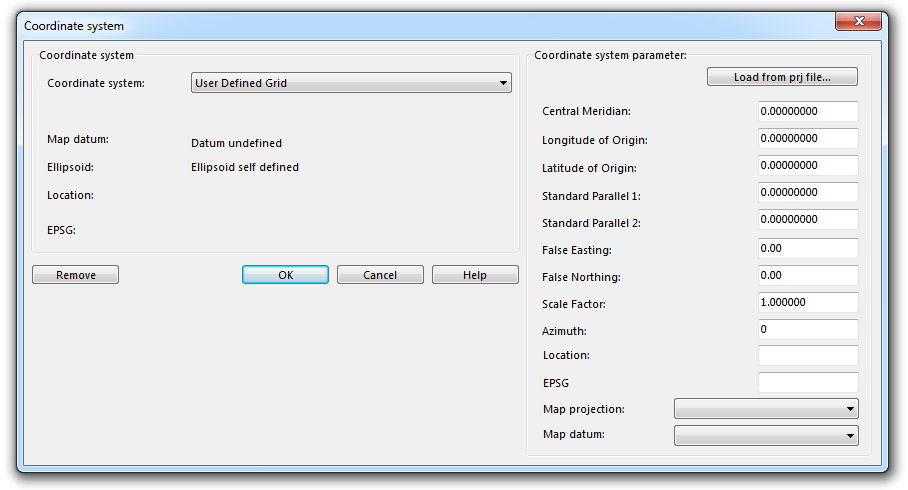Create a New Map: Difference between revisions
(/* Create a New Map File:Space.PNGThis function is available in OCAD 11 Professional.|link=https://www.ocad.com/en/products/ocad-for-cartographyThis function is available in OCAD 11 Orienteering Standard.|link=https://www.ocad.com/en/products/ocad-for-...) |
|||
| (10 intermediate revisions by 2 users not shown) | |||
| Line 1: | Line 1: | ||
OCAD provides predefined symbol sets to help you begin drawing your map immediately. | OCAD provides predefined symbol sets to help you begin drawing your map immediately. | ||
==Create a New Map== | ==Create a New Map [[File:Space.PNG]][[File:Pro40px.PNG|This function is available in OCAD 11 Professional.|link=https://www.ocad.com/en/products/ocad-for-cartography]][[File:Std40px.PNG|This function is available in OCAD 11 Orienteering Standard.|link=https://www.ocad.com/en/products/ocad-for-orienteering]][[File:Sta40px.PNG|This function is available in OCAD 11 Starter.|link=https://www.ocad.com/en/products/ocad-for-orienteering]][[File:CS40px.PNG|This function is available in OCAD 11 Course Setting.|link=https://www.ocad.com/en/products/ocad-for-orienteering]]== | ||
To create a new map: | To create a new map: | ||
| Line 7: | Line 7: | ||
#:[[File:NewFile.PNG]] | #:[[File:NewFile.PNG]] | ||
#Choose a map type. You can now choose a predefined symbol set which fits to your intended map from the selection box. If you want an empty symbol set, choose the '''Empty symbol set''' option. Click the '''Other file''' button to copy the symbols for the new map from a different map than those listed. The box lists all symbol files in the \symbol\ sub directory. To add your own set of symbols to the list of predefined symbol sets, simply copy the OCD file to the OCAD sub directory ''Symbol'' (usually ''C:\program files\OCAD\OCAD11\Symbol''). Symbol files are just normal OCAD maps, usually without any objects. The '''Map notes''' box shows information about the specifications of the map. | #Choose a map type. You can now choose a predefined symbol set which fits to your intended map from the selection box. If you want an empty symbol set, choose the '''Empty symbol set''' option. Click the '''Other file''' button to copy the symbols for the new map from a different map than those listed. The box lists all symbol files in the \symbol\ sub directory. To add your own set of symbols to the list of predefined symbol sets, simply copy the OCD file to the OCAD sub directory ''Symbol'' (usually ''C:\program files\OCAD\OCAD11\Symbol''). Symbol files are just normal OCAD maps, usually without any objects. The '''Map notes''' box shows information about the specifications of the map. | ||
#:[[File:Hint.jpg|hint]] -Do not edit the symbol sets provided by OCAD. When installing a Service Update OCAD overwrites these symbol sets. So your changes will be lost. If you want to modify symbols in the symbol set then first save the symbol set with another file name and edit this symbol file. | |||
#:[[File:Hint.jpg|hint]] -You can add, change or delete symbols in the symbol box at any time. | #:[[File:Hint.jpg|hint]] -You can add, change or delete symbols in the symbol box at any time. | ||
#::-Map notes can be edited in the template file itself. For this purpose choose '''[[Map#Map_Information|Map Information]]''' in the '''Map''' menu. | #::-Map notes can be edited in the template file itself. For this purpose choose '''[[Map#Map_Information|Map Information]]''' in the '''Map''' menu. | ||
| Line 15: | Line 16: | ||
[[File:Camera.jpg|camera]] [http://www.ocad.com/howtos/29.htm Creating a new map] | [[File:Camera.jpg|camera]] [http://www.ocad.com/howtos/29.htm Creating a new map] | ||
==Set Scale and Coordinate System== | ==Set Scale and Coordinate System [[File:Space.PNG]][[File:Pro40px.PNG|This function is available in OCAD 11 Professional.|link=https://www.ocad.com/en/products/ocad-for-cartography]][[File:Std40px.PNG|This function is available in OCAD 11 Orienteering Standard.|link=https://www.ocad.com/en/products/ocad-for-orienteering]][[File:Sta40px.PNG|This function is available in OCAD 11 Starter.|link=https://www.ocad.com/en/products/ocad-for-orienteering]][[File:CS40px.PNG|This function is available in OCAD 11 Course Setting.|link=https://www.ocad.com/en/products/ocad-for-orienteering]]== | ||
Select the '''Set Scale and Coordinate System''' item from the '''Map''' menu. The '''Set Scale and Coordinate System''' dialog box appears. | Select the '''Set Scale and Coordinate System''' item from the '''[[Map]]''' menu. The '''Set Scale and Coordinate System''' dialog box appears. | ||
[[File:SetScaleAnd CoordinateSystem.PNG]] | |||
===Map Scale=== | ===Map Scale=== | ||
Enter a scale and click the '''OK''' button or adjust the '''Coordinates''' settings.<br /> | Enter a scale and click the '''OK''' button or adjust the '''Coordinates''' settings.<br /> | ||
[[File:Hint.jpg|hint]] Do not use this dialog to change the scale after entering the initial values. To increase or decrease the size of the map subsequently, use the '''Change Scale | [[File:Hint.jpg|hint]] Do not use this dialog to change the scale after entering the initial values. To increase or decrease the size of the map subsequently, use the '''[[Map#Change_Scale|Change Scale]]''' function in the '''[[Map]]''' menu. Setting the current scale does not enlarge or reduce the map. It only changes a number in the map file and georeferencing will be lost. | ||
===Georeference the Map=== | ===Georeference the Map=== | ||
Before loading a georeferenced | Before loading a georeferenced '''[[Background Map]]''', work with '''[[GPS]]''' data or import '''[[DEM|Spatial Base Data]]''', we recommend that you first georeference the map. You should contact your data supplier, national surveying office or cartographic institute to find out which coordinate system will best suit your needs. | ||
====Coordinates==== | ====Coordinates==== | ||
# Choose wheter you want define '''Paper coordinates''' (in mm) or '''Real world coordinates'''. Click the corresponding radio button. | # Choose wheter you want define '''Paper coordinates''' (in mm) or '''Real world coordinates'''. Click the corresponding radio button. | ||
# In the '''Easting offset''' and '''Northing offset''' fields, enter the coordinate values for the center of your map. | # In the '''Easting offset''' and '''Northing offset''' fields, enter the coordinate values for the center of your map. | ||
# The coordinate system can be rotated by entering a value in the '''Angle | # The coordinate system can be rotated by entering a value in the '''Angle''' field. | ||
# In the '''Grid distance''' field, enter the desired | # In the '''Grid distance''' field, enter the desired distance for the '''[[View#Show_Screen_Grid|Coordinate Grid]] lines. | ||
[[File:Hint.jpg|hint]] Enter the coordinate values for the center of your map in the horizontal and vertical offset fields. This is important since the drawing area of OCAD is limited to 4 x 4 m in the '''Orienteering Standard''' | [[File:Hint.jpg|hint]] Enter the coordinate values for the center of your map in the horizontal and vertical offset fields. This is important since the drawing area of OCAD is limited to 4 x 4 m in the [[File:Std40px.PNG|link=https://www.ocad.com/en/products/ocad-for-orienteering]] '''Orienteering Standard''' edition, in the [[File:Sta40px.PNG|link=https://www.ocad.com/en/products/ocad-for-orienteering]] '''Starter''' edition as well as in the [[File:CS40px.PNG|link=https://www.ocad.com/en/products/ocad-for-orienteering]] '''Course Setting''' edition and 80 x 80 m in the [[File:Pro40px.PNG|link=https://www.ocad.com/en/products/ocad-for-cartography]] '''Professional Edition'''. This option is used to ensure that imported '''[[DEM|Spatial Base Data]]''', georeferenced '''[[Background Map|Background Maps]]''' and '''[[GPS]]''' measurements do not lie outside the drawing area. | ||
====Coordinate System==== | ====Coordinate System==== | ||
Click the '''Choose''' button to define a coordinate system. The '''Coordinate System''' dialog appears. | Click the '''Choose''' button to define a coordinate system. The '''Coordinate System''' dialog appears. | ||
[[File:CoordinateSystemDialog.PNG]] | |||
Choose the desired coordinate system. OCAD supports a lot of coordinate systems. The most common one is the '''[http://en.wikipedia.org/wiki/Universal_Transverse_Mercator_coordinate_system UTM]''' (Universal Transverse Mercator) system which is divided into 60 zones limited by meridians and defined worldwide. | Choose the desired coordinate system. OCAD supports a lot of coordinate systems. The most common one is the '''[http://en.wikipedia.org/wiki/Universal_Transverse_Mercator_coordinate_system UTM]''' (Universal Transverse Mercator) system which is divided into 60 zones limited by meridians and defined worldwide. | ||
*'''Zone''': Depending on the selected coordinate system you must select a zone. If the coordinate system '''UTM''' is selected you can click the '''Find''' button to find the correct UTM zone. This function is described in the next paragraph. | *'''Zone''': Depending on the selected coordinate system you must select a zone. If the coordinate system '''UTM''' is selected, you can click the '''Find''' button to find the correct UTM zone. This function is described in the next paragraph. | ||
*'''Map datum''': This field displays the map datum for the desired coordinate system ('''[http://en.wikipedia.org/wiki/Datum_%28geodesy%29 Map Datum]'''). | *'''Map datum''': This field displays the map datum for the desired coordinate system ('''[http://en.wikipedia.org/wiki/Datum_%28geodesy%29 Map Datum]'''). | ||
| Line 46: | Line 52: | ||
*'''Location''': The field displays the location, where the coordinate system can be used. | *'''Location''': The field displays the location, where the coordinate system can be used. | ||
*'''EPSG''': The field displays the EPSG-Code (European Petroleum Survey Group Geodesy) of the coordinate system. | *'''EPSG''': The field displays the EPSG-Code (European Petroleum Survey Group Geodesy) of the coordinate system. An external link is provided on the right side of the dialog box. This link refers to '''[http://spatialreference.org/ref/epsg/ spatialreference.org]''', where you can get more information about the chosen coordinate system and zone. | ||
Click the '''Remove''' button to reset the coordinate system to '''Grid undefined'''.<br /> | Click the '''Remove''' button to reset the coordinate system to '''Grid undefined'''.<br /> | ||
| Line 52: | Line 58: | ||
=====Find UTM Zone===== | =====Find UTM Zone===== | ||
If '''[http://en.wikipedia.org/wiki/Universal_Transverse_Mercator_coordinate_system UTM]''' is chosen as a coordinate system, the local zone can be found with this tool. Click the '''Find''' button next to the '''Zone''' dropdown list. The '''Find UTM Zone''' dialog appears. | |||
[[File:FindUTMZone.PNG]] | |||
Enter the geographical coordinate (degree of longitude and degree of latitude) of your map. | |||
*'''Latitude''': Enter in this field the degrees of latitude. | *'''Latitude''': Enter in this field the degrees of latitude. | ||
: '''N (North):''' Click this button if the position is northern of the equator. | : '''N (North):''' Click this button if the position is northern of the equator. | ||
: '''S (South):''' Click this button if the position is southern of the equator. | : '''S (South):''' Click this button if the position is southern of the equator. | ||
*'''Longitude''': Enter in this field the degrees of longitude. | *'''Longitude''': Enter in this field the degrees of longitude. | ||
: '''W (West):''' Click this button if the position is western of Prime Meridian (London Greenwich). | : '''W (West):''' Click this button if the position is western of Prime Meridian (London Greenwich). | ||
: '''E (East):''' Click this button if the position is eastern of Prime Meridian (London Greenwich). | : '''E (East):''' Click this button if the position is eastern of Prime Meridian (London Greenwich). | ||
Click the button '''OK''' to calculate the UTM zone. The UTM zone appears in the Coordinate system dialog box. | Click the button '''OK''' to calculate the UTM zone. The UTM zone appears in the '''Coordinate system''' dialog box. | ||
'''Example''': Coordinate from Baar (Switzerland): 47° 12 North (Latitude), 8° 31' East (Longitude). Enter 47 in the '''Latitude''' and 8 in the '''Longitude''' field. You will find out that this place is in the UTM zone 32 North. | |||
=====User Defined Grid===== | |||
In the '''Coordinate System''' dialog you have the option to choose a '''User Defined Grid''' in the dropdown list. If you choose it, the dialog box is extended with the '''Coordinate system parameter''' part. | |||
[[File:UserDefinedCoordinateSystem.PNG]] | |||
You can load the coordinate system from a PRJ-File by clicking the corresponding button. A PRJ-File is a projection format containing coordinate system and projection information. The coordinate system parameter are updated after loading a PRJ-File. Alternatively, the required values can be typed manually but this requires a little experience. | |||
====Additional local offset==== | ====Additional local offset==== | ||
| Line 71: | Line 86: | ||
Click the '''OK''' button to save changes and quit the '''Set Scale and Coordinate System''' dialog. | Click the '''OK''' button to save changes and quit the '''Set Scale and Coordinate System''' dialog. | ||
[[File:Hint.jpg]] Do not use this dialog to change the real world coordinate offset if the map is georeferenced. To move a georeferenced map, use '''Transform''' -> '''[[Map_Transform#Center_Map_to_Drawing_Area|Center Map to Drawing Area]]''' in the '''Map''' menu and enter the new offset. | [[File:Hint.jpg]] Do not use this dialog to change the real world coordinate offset if the map is georeferenced. To move a georeferenced map, use '''Transform''' -> '''[[Map_Transform#Center_Map_to_Drawing_Area|Center Map to Drawing Area]]''' in the '''[[Map]]''' menu and enter the new offset. | ||
---- | ---- | ||
Latest revision as of 08:40, 24 October 2013
OCAD provides predefined symbol sets to help you begin drawing your map immediately.
Create a New Map 




To create a new map:
- Select New in the File menu. The New File dialog box appears.
- Choose a map type. You can now choose a predefined symbol set which fits to your intended map from the selection box. If you want an empty symbol set, choose the Empty symbol set option. Click the Other file button to copy the symbols for the new map from a different map than those listed. The box lists all symbol files in the \symbol\ sub directory. To add your own set of symbols to the list of predefined symbol sets, simply copy the OCD file to the OCAD sub directory Symbol (usually C:\program files\OCAD\OCAD11\Symbol). Symbol files are just normal OCAD maps, usually without any objects. The Map notes box shows information about the specifications of the map.
 -Do not edit the symbol sets provided by OCAD. When installing a Service Update OCAD overwrites these symbol sets. So your changes will be lost. If you want to modify symbols in the symbol set then first save the symbol set with another file name and edit this symbol file.
-Do not edit the symbol sets provided by OCAD. When installing a Service Update OCAD overwrites these symbol sets. So your changes will be lost. If you want to modify symbols in the symbol set then first save the symbol set with another file name and edit this symbol file. -You can add, change or delete symbols in the symbol box at any time.
-You can add, change or delete symbols in the symbol box at any time.
- -Map notes can be edited in the template file itself. For this purpose choose Map Information in the Map menu.
- -Edit the file OrienteeringMapList.User.txt in the OCAD sub directory Symbol if you want that user defined symbol sets are listed as map type Orienteering map.
- By clicking the OK button, OCAD creates a new map and copies the chosen symbol set to it.
Set Scale and Coordinate System 




Select the Set Scale and Coordinate System item from the Map menu. The Set Scale and Coordinate System dialog box appears.
Map Scale
Enter a scale and click the OK button or adjust the Coordinates settings.
![]() Do not use this dialog to change the scale after entering the initial values. To increase or decrease the size of the map subsequently, use the Change Scale function in the Map menu. Setting the current scale does not enlarge or reduce the map. It only changes a number in the map file and georeferencing will be lost.
Do not use this dialog to change the scale after entering the initial values. To increase or decrease the size of the map subsequently, use the Change Scale function in the Map menu. Setting the current scale does not enlarge or reduce the map. It only changes a number in the map file and georeferencing will be lost.
Georeference the Map
Before loading a georeferenced Background Map, work with GPS data or import Spatial Base Data, we recommend that you first georeference the map. You should contact your data supplier, national surveying office or cartographic institute to find out which coordinate system will best suit your needs.
Coordinates
- Choose wheter you want define Paper coordinates (in mm) or Real world coordinates. Click the corresponding radio button.
- In the Easting offset and Northing offset fields, enter the coordinate values for the center of your map.
- The coordinate system can be rotated by entering a value in the Angle field.
- In the Grid distance field, enter the desired distance for the Coordinate Grid lines.
![]() Enter the coordinate values for the center of your map in the horizontal and vertical offset fields. This is important since the drawing area of OCAD is limited to 4 x 4 m in the
Enter the coordinate values for the center of your map in the horizontal and vertical offset fields. This is important since the drawing area of OCAD is limited to 4 x 4 m in the Orienteering Standard edition, in the
Starter edition as well as in the
Course Setting edition and 80 x 80 m in the
Professional Edition. This option is used to ensure that imported Spatial Base Data, georeferenced Background Maps and GPS measurements do not lie outside the drawing area.
Coordinate System
Click the Choose button to define a coordinate system. The Coordinate System dialog appears.
Choose the desired coordinate system. OCAD supports a lot of coordinate systems. The most common one is the UTM (Universal Transverse Mercator) system which is divided into 60 zones limited by meridians and defined worldwide.
- Zone: Depending on the selected coordinate system you must select a zone. If the coordinate system UTM is selected, you can click the Find button to find the correct UTM zone. This function is described in the next paragraph.
- Map datum: This field displays the map datum for the desired coordinate system (Map Datum).
- Ellipsoid: The field displays the ellipsoid from the map datum (Reference Ellipsoid).
- Location: The field displays the location, where the coordinate system can be used.
- EPSG: The field displays the EPSG-Code (European Petroleum Survey Group Geodesy) of the coordinate system. An external link is provided on the right side of the dialog box. This link refers to spatialreference.org, where you can get more information about the chosen coordinate system and zone.
Click the Remove button to reset the coordinate system to Grid undefined.
If you are finished, click the OK button.
Find UTM Zone
If UTM is chosen as a coordinate system, the local zone can be found with this tool. Click the Find button next to the Zone dropdown list. The Find UTM Zone dialog appears.
Enter the geographical coordinate (degree of longitude and degree of latitude) of your map.
- Latitude: Enter in this field the degrees of latitude.
- N (North): Click this button if the position is northern of the equator.
- S (South): Click this button if the position is southern of the equator.
- Longitude: Enter in this field the degrees of longitude.
- W (West): Click this button if the position is western of Prime Meridian (London Greenwich).
- E (East): Click this button if the position is eastern of Prime Meridian (London Greenwich).
Click the button OK to calculate the UTM zone. The UTM zone appears in the Coordinate system dialog box.
Example: Coordinate from Baar (Switzerland): 47° 12 North (Latitude), 8° 31' East (Longitude). Enter 47 in the Latitude and 8 in the Longitude field. You will find out that this place is in the UTM zone 32 North.
User Defined Grid
In the Coordinate System dialog you have the option to choose a User Defined Grid in the dropdown list. If you choose it, the dialog box is extended with the Coordinate system parameter part.
You can load the coordinate system from a PRJ-File by clicking the corresponding button. A PRJ-File is a projection format containing coordinate system and projection information. The coordinate system parameter are updated after loading a PRJ-File. Alternatively, the required values can be typed manually but this requires a little experience.
Additional local offset
It is possible to give an additional local offset to the chosen coordinate system. Enter a value for the horizontal and vertical offset in the corresponing fields. This is especially useful if you have to work with GPS very precisely. A tectonic plate can move but the coordinate system stays the same. If you enter a local offset, this problem can be cleared.
Click the OK button to save changes and quit the Set Scale and Coordinate System dialog.
![]() Do not use this dialog to change the real world coordinate offset if the map is georeferenced. To move a georeferenced map, use Transform -> Center Map to Drawing Area in the Map menu and enter the new offset.
Do not use this dialog to change the real world coordinate offset if the map is georeferenced. To move a georeferenced map, use Transform -> Center Map to Drawing Area in the Map menu and enter the new offset.
Previous Chapter: Graphical User Interface
Next Chapter: Colors
Back to Main Page
To the Map page.




